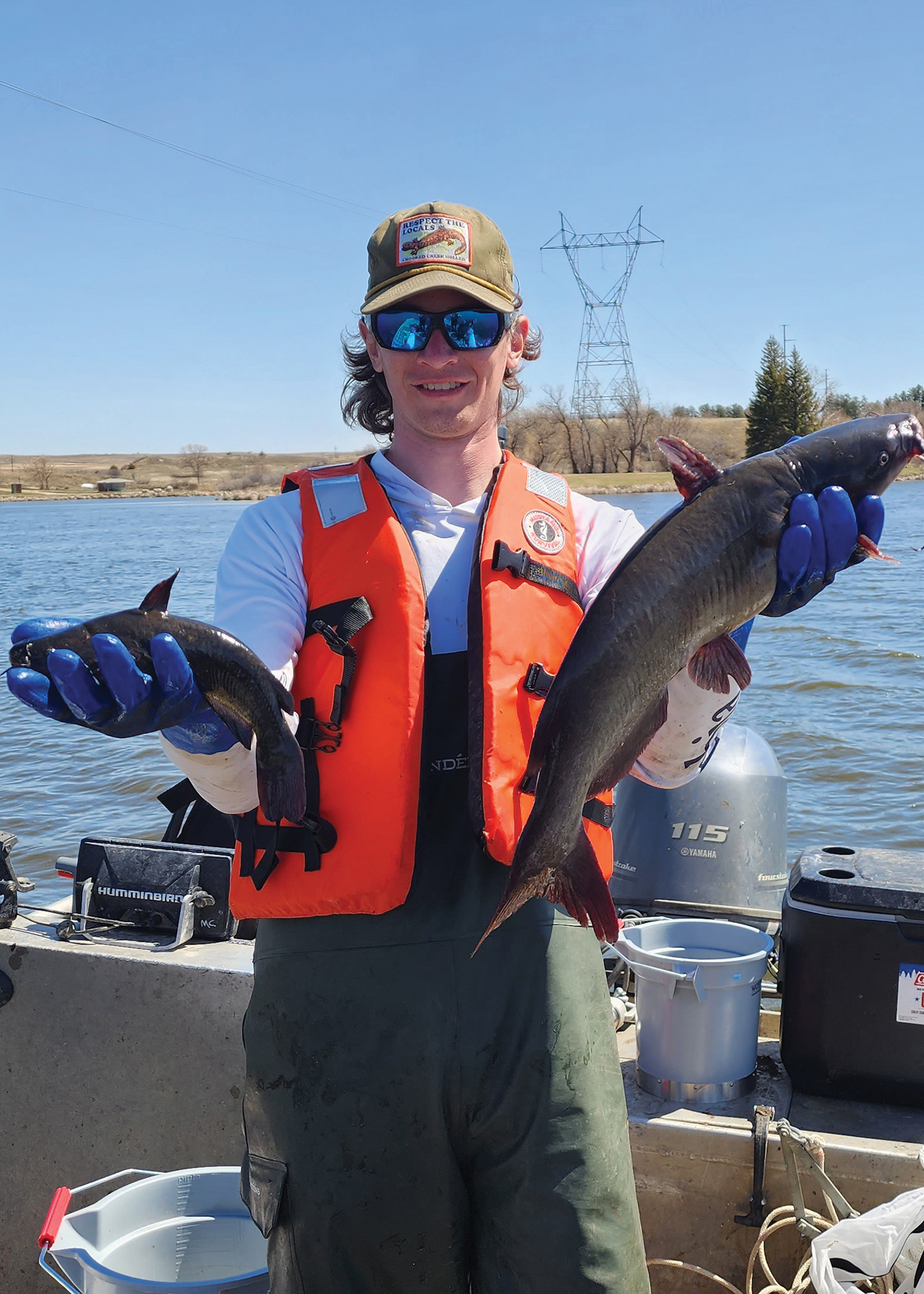Trimming a Bloated Bullhead Population
By Ron Wilson

The North Dakota Game and Fish Department introduced a predator into a Morton County lake in 2023 in hopes of controlling a bloated bullhead population that provides little value to anglers.
The introduction of thousands of channel catfish into the 278-acre Sweet Briar Lake last spring was the start of a two-year collaborative study with the University of North Dakota.
“Sweet Briar Lake was a good candidate for this study because it does have a dense population of bullheads. While it is still a very popular fishery, close to the large population center of Bismarck-Mandan, the quality of fishing just isn’t where we want it to be right now,” said Paul Bailey, Department south central district fisheries supervisor. “The bullhead population has really impacted the angling value of Sweet Briar Lake, so it was a good candidate lake for us to investigate this technique. We’ve had success using channel catfish to control black bullhead populations in some smaller fisheries, so this was an effort to try and scale up this operation to see if we could have success controlling black bullheads in a larger fishery.”
Sweet Briar isn’t the only North Dakota fishery that has an abundance of bullheads, which isn’t a good thing when you consider a lake can harbor only so much life.
“Every lake only has a certain amount of energy within that system, and there’s only a certain amount of space for the fish in there,” said Tyler Bennett, UND master’s student conducting the field sampling in the study. “When you have these overabundant black bullhead populations, that takes away space and productivity that can go into your more desirable game fish populations like walleye, northern pike, yellow perch or bluegills.”
Bailey added that while the goal is to significantly trim the bullhead population, an added benefit is the thousands of catfish released into the lake over time will also provide some value to anglers.
The roughly 4,000 catfish, weighing about 2 pounds on average, stocked in Sweet Briar for the study were trapped in Lake Oahe in April 2023.
“It was a big undertaking and that represented just shy of 10,000 pounds of catfish,” Bailey said. “It was a pretty labor-intensive process, which is another reason we would like some better guidance on this to make sure that we’re spending our manpower and our resources in the best way possible to utilize these catfish for controlling nuisance bullhead populations.”
In spring, Bennett and crew conducted a mark-recapture estimate on bullheads in the lake. Of those bullheads captured in nets, they clipped the adipose fins on fish longer that 6 inches.
“And what we ended up finding out is that there are a lot of bullheads in Sweet Briar,” Bennett said. “Our population estimate was over a quarter million. That’s an extremely large population for a 200-plus acre lake. That’s just the fish greater than 6 inches and there was probably as many, if not more, smaller bullheads that we didn’t take into consideration.”
Throughout the study, Bennett and Department fisheries personnel have netted a number of catfish. These fish were then taken to a lab to determine what was making up their diet.
“So, once we have that information, we can then see what’s the importance of black bullheads to a channel catfish’s diet in Sweet Briar,” Bennett said. “Are bullheads an important prey item for channel catfish? If so, to what extent? And do we then expect to see the channel catfish then predate so heavily on bullheads that that population might collapse?”
It’s been revealed in the still-young study that, yes, channel catfish are preying on Sweet Briar’s abundant bullhead population, but they’re are also opportunistic when it comes to eating.
“So far, we’ve seen that these catfish have certainly fed fairly well on black bullheads, especially when we initially stocked them this spring,” Bailey said. “Then these catfish tended to shift their diet a little bit during summer, eating more crayfish, and because we had a good hatch of grasshoppers, they were eating grasshoppers that ended up in the lake.”
In spring, when the catfish were introduced to Sweet Briar, Bennett said bullheads made up about 40% of total mass within a catfish’s diet. The hope was, as the grasshopper population thinned, along with other summertime foraging items, that the catfish would return to concentrating on bullheads.
Because fisheries managers have so few tools to manage troublesome bullhead populations in North Dakota waters, it’s hoped the findings from the two-year study will reveal a solution.
“What we wish to gain is some better guidance on how to use this technique of using channel catfish to control bullheads,” Bailey said. “If so, we’ll be able to apply it to other lakes that are having issues with bullhead overabundance, with the idea of improving angling opportunities in those waters as well.”
